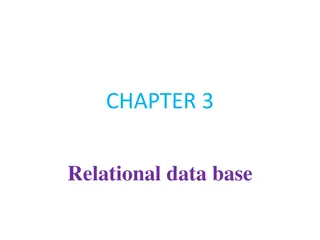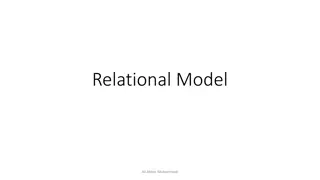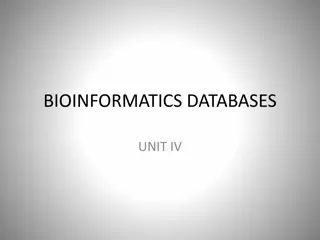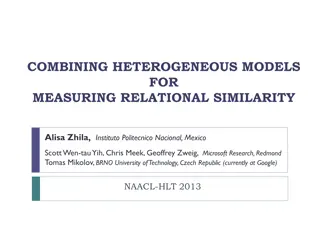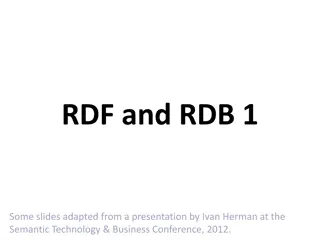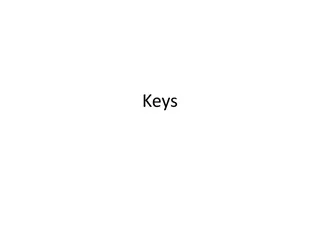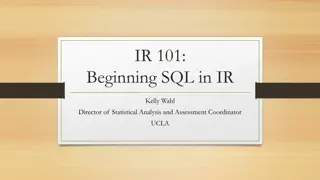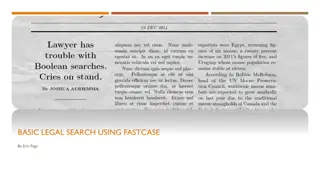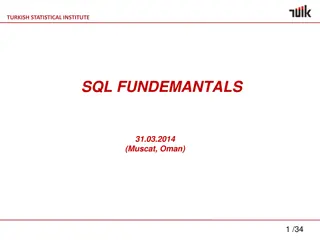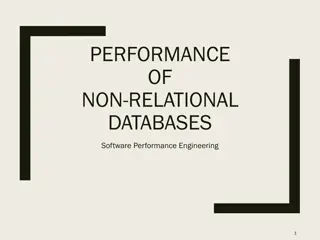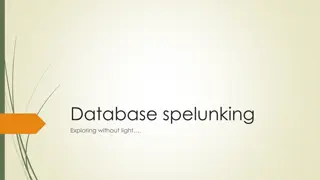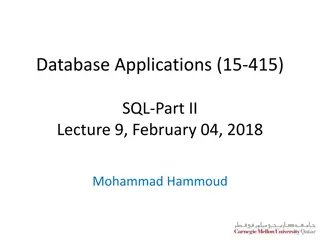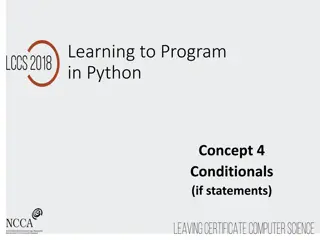Fundamentals of Relational Databases in CSCE 315 - Lecture Highlights
Introduction to relational databases covering topics such as relational data model, schemas, converting from entity-relationship model, entity sets, relations, relationships, combining relations, and practical examples. Learn about storing data in tables, attributes, database organization, and the importance of maintaining data integrity.
Download Presentation

Please find below an Image/Link to download the presentation.
The content on the website is provided AS IS for your information and personal use only. It may not be sold, licensed, or shared on other websites without obtaining consent from the author. Download presentation by click this link. If you encounter any issues during the download, it is possible that the publisher has removed the file from their server.
E N D
Presentation Transcript
RELATIONAL DATABASES CSCE 315, SPRING 2019 PROJECT 1, LECTURE 2 ROBERT LIGHTFOOT Slides adapted from those used by Jeffrey Ullman, via Jennifer Welch
RELATIONAL DATA MODEL Relations and Entities are stored in Tables e.g. Sponsor (Senator, Bill) Atrributes Sponsor Senator Smith Jones Smith Adams Bill Tax Defense Defense Commerce Tuples
SCHEMAS A relation schema (aka Table schema) is a relation name and a list of attributes Sponsor(Senator,Bill) A database is a collection of relations A database schema is the set of all the relation schemas in the database Remember, Relation Table
CONVERTING FROM ENTITY- RELATIONSHIP MODEL ER: Entity set -> relation ER Attributes become Relational attributes ER: Relationship -> relation Keys of connected ER entity sets become Relational attributes
ER ENTITY SETS Name Party Organization Senator Lobbyist State Name Years Bill Name Text
RELATIONS Senator(Name,Party,State,Years) Bill(Name,Text) Lobbyist(Name,Organization)
ER RELATIONSHIPS Name Contributed Party Organization Senator Lobbyist State Name Years Sponsored Wrote Bill Name Text
RELATIONS Sponsored(Senator,Bill) Wrote(Bill,Lobbyist) Contributed(Senator,Lobbyist) Remember, each of these is expressed as a table with the columns given by the atributes
COMBINING RELATIONS Relations can sometimes be combined. Assume a base entity set with its relation. If there is a many-to-one relation, then it can be combined with the base entity set. Should not combine many-to-many Would cause redundancy each of the many stored
COMBINING RELATIONS Example (many-to-one): (Good) Person(Name, Birthdate, Height, Weight, Eye Color, Hair Color) BornIn(Person,Town) Combined: Person(Name, Birthdate, Height, Weight, Eye Color, Hair Color, Town) Only one Town per Person Example(many-to-many): (Bad) Senator(Name, Party, State, Years) Sponsored(Senator, Bill) Combined: Senator(Name, Party, State, Years, Bill) Many Bills per Senator
WEAK ENTITY SETS The relation for a weak entity set must contain all the elements of its key Supporting relationships are usually redundant (unless possibly multi-way)
WEAK ENTITY SET EXAMPLE First Name Last Name Number Note arrrow: indicates many to one. Position Baseball Player Birthdate Plays On Team Nationality Salary Name City
WEAK ENTITY SET EXAMPLE Team(Name, City) Baseball Player(Number, TeamName, First Name, Last Name, Position, Birthdate, Nationality, Salary)
WEAK ENTITY SET EXAMPLE Team(Name, City) Baseball Player(Number, TeamName, First Name, Last Name, Position, Birthdate, Nationality, Salary) Note that we don t need PlaysOn(BaseballPlayer.Number, BaseballPlayer.TeamName, Team.Name)
WEAK ENTITY SET EXAMPLE Team(Name, City) Baseball Player(Number, TeamName, First Name, Last Name, Position, Birthdate, Nationality, Salary) Note that we don t need PlaysOn(BaseballPlayer.Number, BaseballPlayer.TeamName, Team.Name) Redundant (same)
WEAK ENTITY SET EXAMPLE Team(Name, City) Baseball Player(Number, TeamName, First Name, Last Name, Position, Birthdate, Nationality, Salary) Note that we don t need PlaysOn(BaseballPlayer.Number, BaseballPlayer.Team.Name)
WEAK ENTITY SET EXAMPLE Team(Name, City) Baseball Player(Number, TeamName, First Name, Last Name, Position, Birthdate, Nationality, Salary) Note that we don t need PlaysOn(BaseballPlayer.Number, BaseballPlayer.Team.Name) Already Included
KEYS A Key functionally determines all other attributes of the relation Given a relation and a key, there is only one tuple that corresponds to it There are subtle differences from an E-R key, which we won t go into.


